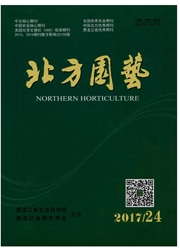

 中文摘要:
中文摘要:
采用小麦、燕麦与黄瓜伴生,毛葱、白菜、芹菜与黄瓜套作,研究了不同栽培方式对黄瓜病害和品质的影响。结果表明:不同栽培方式均显著降低了霜霉病和角斑病的发病率和病情指数,其中芹菜-黄瓜和白菜-黄瓜处理效果最佳,霜霉病发病率分别降低42.8%和46.4%;小麦-黄瓜,燕麦-黄瓜和毛葱-黄瓜处理白粉病的发病率分别降低了66.3%、65.2%和83.2%。毛葱-黄瓜处理显著提高了黄瓜果实维生素C和可溶性蛋白的含量,但也提高了硝酸盐的含量;白菜-黄瓜处理显著降低了果实硝酸盐的含量,芹菜-黄瓜处理显著降低了维生素C的含量。小麦-黄瓜、燕麦-黄瓜、毛葱-黄瓜和芹菜-黄瓜均显著降低了可溶性固形物的含量。
 英文摘要:
英文摘要:
Concomitance of wheat,oat and cucumber,intercropping of Chinese onion,Chinese cabbage,celery and cucumber were studied for impact on diseases and quality of cucumber under different cultivation management.The results showed that the occurrence and severity of both downy mildew and angular leaf spot were decreased significantly with either cultivation method,among which best results showed with intercropping of celery-cucumber and Chinese cabbage-cucumber,downy mildew incidence reduced by 42.8% and 46.4% respectively;occurrence and severity of downy mildew were remarkably decreased in treatment of wheat-cucumber,oat-cucumber and Chinese onion-cucumber,powdery mildew incidence reduced by 66.3%,65.2% and 83.2% respectively.Content of vitamin C and soluble protein in cucumber were significantly increased in treatment of Chinese onion-cucumber,while the concentration of nitrate was increased as well.The content of nitrate was significantly lowered in treatment of Chinese cabbage-cucumber;content of vitamin C was notably decreased in treatment of celery-cucumber.The content of soluble solid was significantly reduced in treatment of wheat-cucumber,Chinese onion-cucumber and celery-cucumber.
 同期刊论文项目
同期刊论文项目
 同项目期刊论文
同项目期刊论文
 Soil phenolics in a continuously mono-cropped cucumber (Cucumis sativus L.) system and their effects
Soil phenolics in a continuously mono-cropped cucumber (Cucumis sativus L.) system and their effects Allelopathic effects of root exudates of Chinese onion accessions on cucumber yield and Fusarium oxy
Allelopathic effects of root exudates of Chinese onion accessions on cucumber yield and Fusarium oxy Responses of soil microbial communities in the rhizosphere of cucumber (Cucumis sativus L.) to exoge
Responses of soil microbial communities in the rhizosphere of cucumber (Cucumis sativus L.) to exoge 期刊信息
期刊信息
